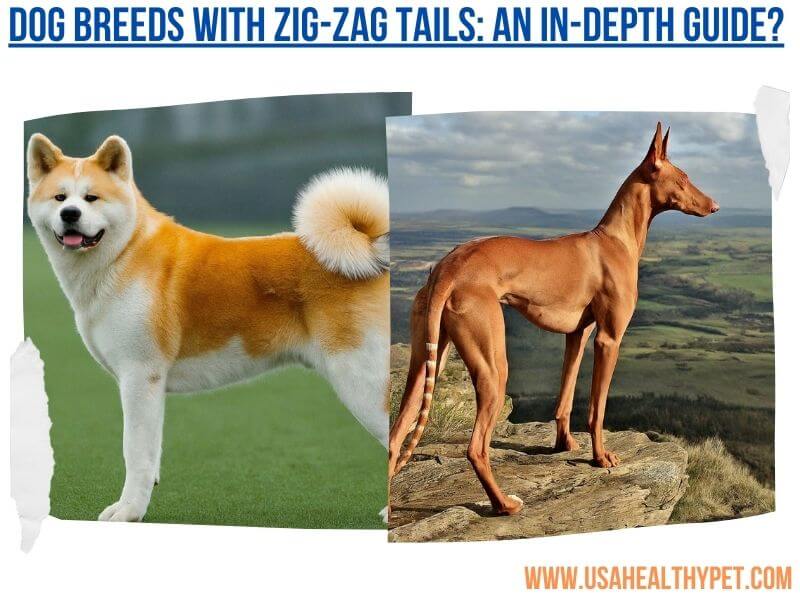Introduction
Have you ever noticed how unique a dog’s tail can be? While some dogs sport the typical straight or curly tails, a few breeds stand out with their zig-zag tails. These dogs are eye-catching and possess a charm that is hard to ignore.
Whether you’ve seen one in person or are just curious, this article will walk you through everything you need to know about zig-zag-tailed dog breeds.
Physical Characteristics
Understanding the Zig-Zag Tail Structure
So, what exactly is a zig-zag tail? Unlike a straight or curled tail, a zig-zag tail has distinct bends or angles that give it a wavy appearance.
This formation can be due to the way the bones in the tail are structured or how the muscles and ligaments are aligned. While it might seem unusual, it’s just another delightful variation in the diverse world of dog tails.
Coat and Color Variations
Zig-zag-tailed dogs come in a variety of coat types and colors. You’ll find short-haired, sleek coats as well as dense, fluffy ones.
Colors range widely too, from solid shades like black, white, and brown, to more complex patterns like brindle and sable. The diversity in their appearance makes these dogs even more fascinating.
Origins of Zig-Zag-Tailed Dog Breeds
Historical Background
The origins of zig-zag-tailed dogs are as intriguing as their tails themselves. Some ancient cultures considered dogs with uniquely shaped tails to be special, attributing to them mystical powers or protection against evil spirits.
Historical records and folklore often depict these dogs as guardians and loyal companions.
Geographical Origins
While zig-zag-tailed dogs are not tied to a specific region, certain breeds commonly exhibiting this trait have origins in specific areas.
For example, the Canaan Dog, which often has a zig-zag tail, hails from the Middle East, while the Basenji, another breed with this tail feature, originates from Central Africa.
Popular Dog Breeds with Zig-Zag on Tail
Basenji: The Barkless Wonder
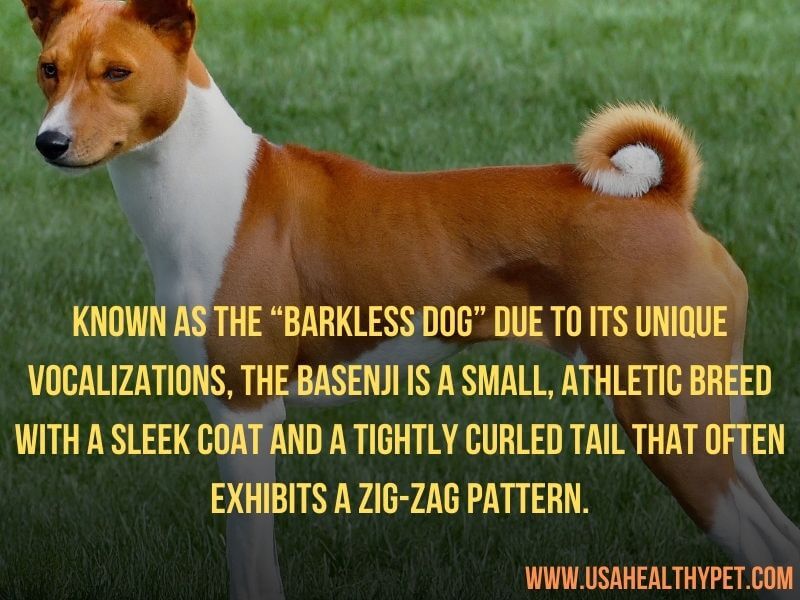
The Basenji is one of the most ancient dog breeds, hailing from Central Africa. Known as the “barkless dog” due to its unique vocalizations, the Basenji is a small, athletic breed with a sleek coat and a tightly curled tail that often exhibits a zig-zag pattern.
These dogs are independent, intelligent, and have a cat-like grooming habit. If you’re considering a Basenji, be prepared for a dog that’s both playful and a bit of a free spirit.
Key Features:
- Tail Pattern: Tightly curled with a zig-zag shape.
- Size: Small and athletic.
- Personality: Independent, intelligent, and playful.
- Care Needs: Low grooming maintenance due to a short coat.
Expert Opinion: “The Basenji’s unique vocalizations and independent nature make them a breed like no other. Their zig-zag tail is just one of many distinctive features that set them apart.”
— Dr. Alice Greene, Veterinarian and Dog Behavior Specialist
Akita: The Loyal Guardian
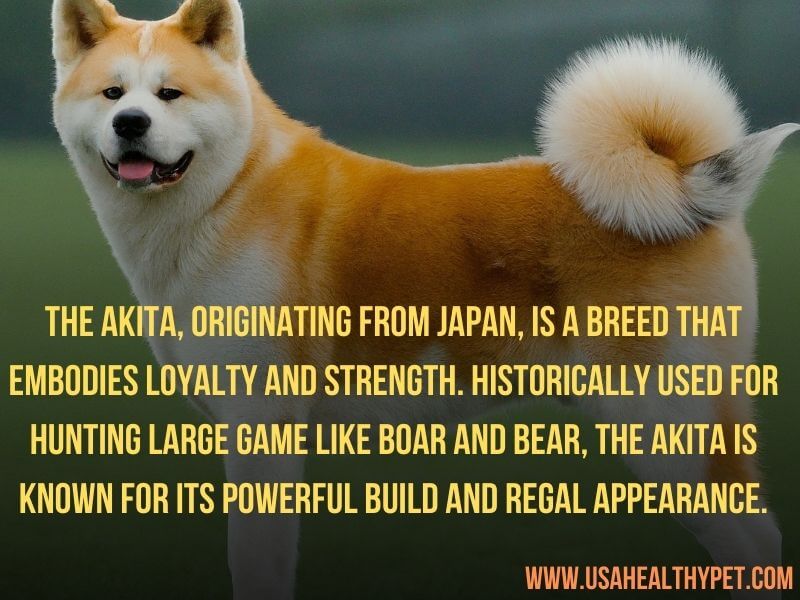
The Akita, originating from Japan, is a breed that embodies loyalty and strength. Historically used for hunting large game like boar and bear, the Akita is known for its powerful build and regal appearance.
Their tails, which curl over their backs, can sometimes have a zig-zag kink, adding to their distinctive look. Akitas are known for their protective nature, making them excellent guard dogs, but they also require firm, consistent training and socialization.
Key Features:
- Tail Pattern: Curled over the back, sometimes with a zig-zag kink.
- Size: Large and powerful.
- Personality: Loyal, protective, and reserved with strangers.
- Care Needs: Requires consistent training and regular grooming.
Expert Opinion: “Akitas are the epitome of loyalty and courage. Their zig-zag tail adds to their majestic appearance, making them one of the most striking and noble breeds.”
— John Miller, Canine Historian and Author of Guardians of Japan
Catahoula Leopard Dog: The Versatile Worker

The Catahoula Leopard Dog is a breed that’s as versatile as it is striking. Originating in the southern United States, this breed was developed for herding and hunting in the swamps and forests of Louisiana.
Their coats come in a range of patterns, and their tails, which can sometimes have a zig-zag appearance, are just as unique as their personalities.
Catahoulas are hardworking, and intelligent, and need plenty of exercise and mental stimulation to stay happy.
Key Features:
- Tail Pattern: Sometimes, it shows a zig-zag appearance.
- Size: Medium to large, athletic build.
- Personality: Hardworking, intelligent, and driven.
- Care Needs High exercise and mental stimulation requirements.
Expert Opinion: “The Catahoula Leopard Dog’s zig-zag tail complements its unique coat patterns, making it one of the most visually striking breeds. Their versatility and work ethic are unmatched in the canine world.”
— Dr. Emily Carter, Canine Geneticist
Pharaoh Hound: The Ancient Egyptian Hunter
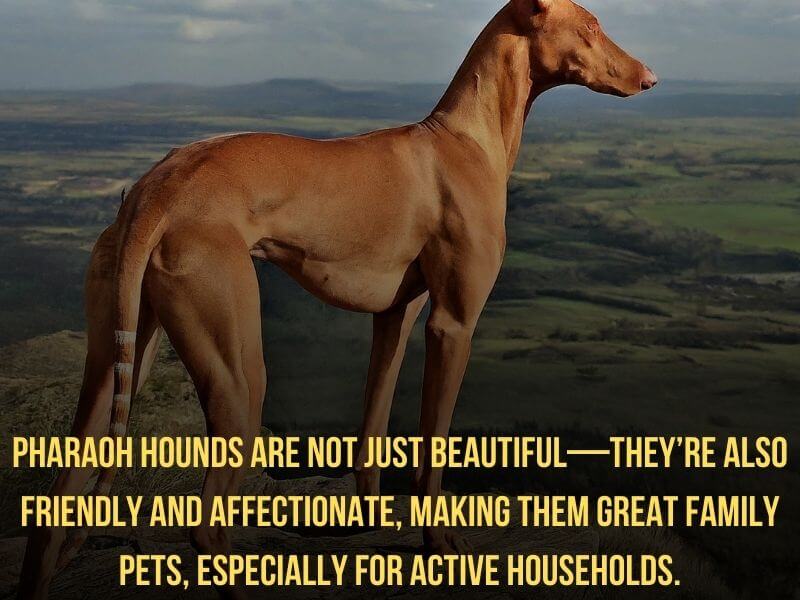
The Pharaoh Hound, often associated with ancient Egypt, is a sleek and elegant breed that’s known for its speed and grace.
These dogs have a distinctive tail that sometimes zig-zags, adding to their exotic appearance.
Pharaoh Hounds are not just beautiful—they’re also friendly and affectionate, making them great family pets, especially for active households.
Key Features:
- Tail Pattern: Occasionally zig-zags.
- Size: Medium, sleek, and athletic.
- Personality: Friendly, affectionate, and energetic.
- Care Needs: Requires daily exercise and minimal grooming.
Expert Opinion: “The Pharaoh Hound is a blend of elegance and athleticism. Its occasional zig-zag tail is a reminder of the breed’s ancient heritage and enduring beauty.”
— Linda Howard, Author of Dogs Through the Ages
Finnish Spitz: The National Dog of Finland
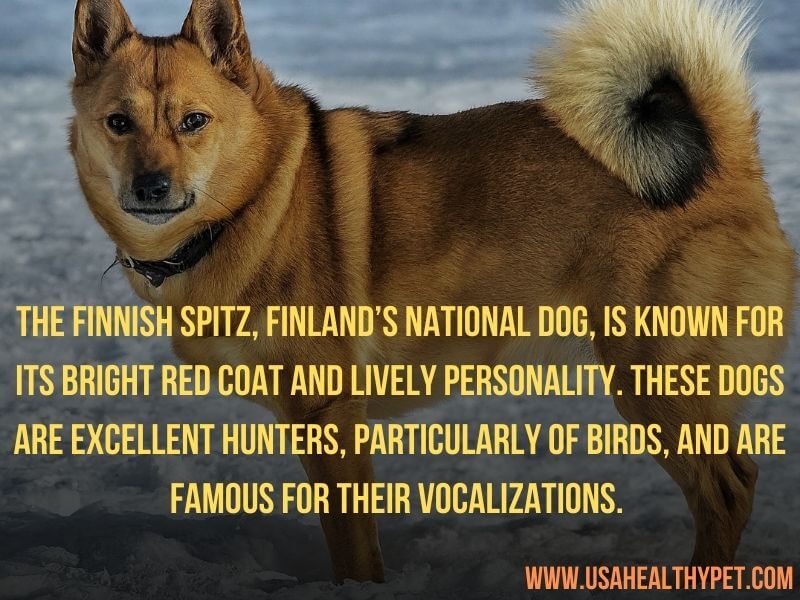
The Finnish Spitz, Finland’s national dog, is known for its bright red coat and lively personality. These dogs are excellent hunters, particularly of birds, and are famous for their vocalizations.
Their tails, often carried high and slightly curled, can also show a zig-zag pattern. Finnish Spitz dogs are playful and energetic, requiring plenty of exercise and a lot of attention to stay content.
Key Features:
- Tail Pattern: High, slightly curled with a possible zig-zag.
- Size: Medium with a bright red coat.
- Personality: Playful, vocal, and energetic.
- Care Needs: Regular exercise and weekly brushing.
Expert Opinion: “The Finnish Spitz’s zig-zag tail and vocal nature make it a unique and beloved breed in Finland. Their playful energy and striking appearance make them wonderful companions for active families.”
— Dr. Helena Lehto, Finnish Veterinary Specialist
Lesser-Known Breeds with Zig-Zag Tails
Some breeds with zig-zag tails aren’t as well-known but are just as fascinating. Here’s a brief overview:
| Breed | Origin | Key Features | Personality | Care Tips |
|---|---|---|---|---|
| Norwegian Buhund | Norway | Medium-sized, spitz-type dog with a curled, zig-zag tail | Intelligent, energetic, loyal | Requires regular exercise and consistent training. |
| Alaskan Klee Kai | United States | Small, husky-like appearance with a distinct tail | Alert, curious, and full of personality | Needs daily exercise and mental stimulation. |
Other Rare Breeds with Zig-Zag Tails:
- Some mixed breeds and rare dog breeds may also have zig-zag tails, adding an extra layer of uniqueness to their already diverse backgrounds.
Choosing the Right Zig-Zag-Tailed
When considering adopting a dog with a zig-zag tail, it’s important to match the breed’s characteristics with your lifestyle.
Considerations:
- Lifestyle: Active breeds like the Catahoula Leopard Dog need lots of exercise, while breeds like the Basenji are more independent.
- Space: Larger breeds like the Akita require more space, while smaller breeds like the Alaskan Klee Kai might adapt better to apartment living.
- Family Dynamics: Some breeds are better with children and other pets, so consider the breed’s temperament and your family setup.
Pros and Cons Table:
| Pros | Cons |
|---|---|
| Unique and visually distinctive appearance | May require more grooming and maintenance |
| Often highly intelligent and loyal | Some breeds can be stubborn or independent |
| Great for active families | Not all breeds are suited for apartment living |
Caring for a Dog with a Zig-Zag Tail
Grooming and Maintenance
Grooming Essentials:
- Regular Brushing: Helps maintain coat health and prevent matting, especially in breeds with thicker fur.
- Tail Care: Pay extra attention to the tail during grooming to prevent tangles or mats.
Additional Tips:
- Bathing: Depending on the breed, baths might be needed more frequently, especially if the dog is very active.
- Nail Trimming: Regular trimming is essential to keep your dog comfortable.
Exercise and Mental Stimulation
Exercise Needs:
- Daily Physical Activity: Whether it’s a brisk walk, run, or playtime, these breeds need regular exercise.
- Mental Challenges: Puzzle toys, training exercises, and agility activities are great ways to keep them mentally stimulated.
Conclusion
Dog breeds with zig-zag tails are truly remarkable and unique. Each breed, from the independent Basenji to the loyal Akita, brings its own charm, personality, and history to the table.
These tails are more than just a visual trait—they often carry deep-rooted significance tied to the breed’s original purpose and environment.
Whether you’re considering one of these breeds for your family or simply fascinated by their distinctive tails, appreciating their uniqueness helps us understand and celebrate the incredible diversity in the canine world.
FAQs
Are zig-zag tails hereditary?
Yes, zig-zag tails are typically hereditary, passed down through generations due to specific genetic traits.
Do zig-zag tails affect a dog’s balance?
No, zig-zag tails do not negatively affect a dog’s balance. In fact, tails play a crucial role in helping dogs maintain balance during movement.
Can a zig-zag tail straighten out over time?
A zig-zag tail is usually a permanent feature, shaped by the structure of the tail’s vertebrae, and does not straighten out over time.
Is a zig-zag tail common in mixed breeds?
It’s possible, though less common. Mixed breeds can inherit a zig-zag tail if one of the parents carries the gene responsible for this trait.
What should I do if my dog’s tail develops a zig-zag shape suddenly?
If your dog’s tail develops a zig-zag shape suddenly, it could be a sign of injury or a health issue. It’s best to consult with a veterinarian to determine the cause.
